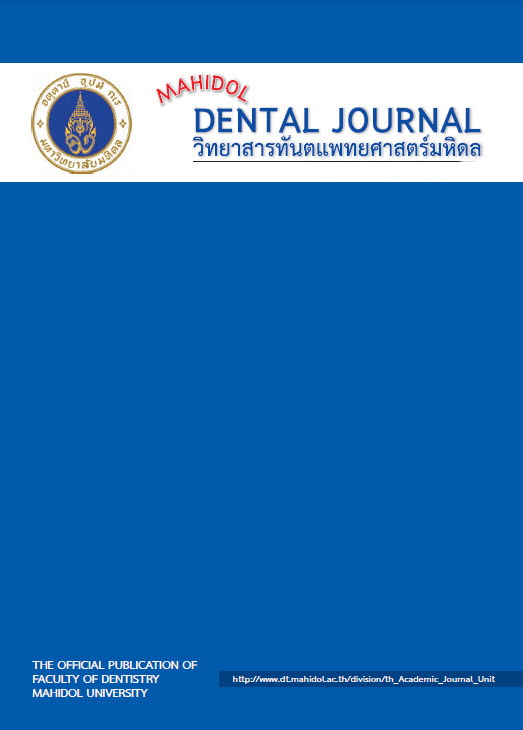Relationship of students’ performance in physics and related subjects in dental curriculum, Mahidol University
Main Article Content
Abstract
Objective: To examine the relationship between basic physics grades and dental students’ academic performance in the subsequent physics-related subjects in Mahidol dental curriculum.
Materials and methods: This study employed a quantitative research approach using a retrospective study to examine the relationship between students’ performance in basic physics courses (SCPY 153 and SCPY 154) taught in the first year of dental curriculum and physics-related subjects (DTBC 235, DTID 244, DTPS 241, DTPS 242, and DTRD 331) in the subsequent years of Mahidol dental curriculum. The data of a cohort of 322 undergraduates who were studying in the fourth to the final year in academic year 2017 were analyzed using descriptive statistical analysis, Pearson’s correlation, and multiple linear regression, with a statistical significance taken at p < 0.05.
Results: There were statistically significant correlations between the grades of the two basic physics courses and all five physics-related subjects. However, weaker correlations for those physics-related subjects were found with SCPY 153 (0.142 < r < 0.267), compared to SCPY 154 (0.300 < r < 0.444). According to regression models, SCPY 154 grades significantly and positively influenced grades of all physics-related subjects (p < 0.001), whilst grades of SCPY 153 significantly affected only grades of DTID 244.
Conclusion: The two physics grades in the first year had influences on students’ academic performance in physics-related courses in the subsequent years. The medical physics course was a predictor of all physics-related dentistry subjects, whist the basic physics course predicts only one dentistry subject.
Article Details
References
2. Woods NN, Brooks LR, & Norman GR. The value of basic science in clinical diagnosis: creating coherence among signs and symptoms. Medical Education. 2005; 39(1): 107-12.
3. Pangaro LN. The Role and Value of the Basic Sciences in Medical Education: The perspective of clinical education-students' progress from understanding to action. Medical Science Educator. 2010; 20: 307-13.
4. Bueche FJ, & Jerde DA. Principles of Physics. 5th edition ed. New York: McGraw-Hill; 1988.
5. Gabel AB. The Role of Physics in Dentistry. Journal of Applied Physics. 1941; 12(10): 712-7.
6. Bidez MW, & Misch CE. Force Transfer in Implant Dentistry: Basic concepts and principles. Journal of Oral Implantology. 1992; 18(3): 264-74.
7. Wiskott HW, Nicholls JI, & Belser UC. Stress Fatigue: Basic principles and prosthodontic implications. The International journal of prosthodontics. 1995; 8(2): 105-16.
8. Wootton DM, & Ku DN. Fluid Mechanics of Vascular Systems, Diseases, and Thrombosis. Annual Review of Biomedical Engineering. 1999; 1(1): 299-329.
9. Şahin S, Çehreli MC, & Yalçın E. The Influence of Functional Forces on the Biomechanics of Implant-Supported Prostheses-A review. Journal of Dentistry. 2002; 30(7): 271-82.
10. Rowlands JA. The physics of computed radiography. Physics in Medicine & Biology. 2002; 47(23): R123.
11. Ren Y, Maltha JC, & Kuijpers-Jagtman AM. Optimum Force Magnitude for Orthodontic Tooth Movement: A systematic literature review. The Angle Orthodontist. 2003; 73(1): 86-92.
12. Taylor TD, Wiens J, & Carr A. Evidence-based considerations for removable prosthodontic and dental implant occlusion: A literature review. The Journal of Prosthetic Dentistry. 2005; 94(6): 555-60.
13. Baier RE. Surface Behaviour of Biomaterials: The theta surface for biocompatibility. Journal of Materials Science: Materials in Medicine. 2006; 17(11): 1057.
14. Vignon-Clementel IE, Alberto Figueroa C, Jansen KE, & Taylor CA. Outflow boundary conditions for three-dimensional finite element modeling of blood flow and pressure in arteries. Computer Methods in Applied Mechanics and Engineering. 2006; 195(29): 3776-96.
15. Badawi HM, Toogood RW, Carey JPR, Heo G, & Major PW. Three-Dimensional Orthodontic Force Measurements. American Journal of Orthodontics and Dentofacial Orthopedics. 2009; 136(4): 518-28.
16. Komabayashi T, Raghuraman K, Raghuraman R, Toda S, Kawamura M, Levine SM, & Bird WF. Dental Education in India and Japan: Implications for U.S. Dental Programs for Foreign-Trained Dentists. Journal of Dental Education. 2005; 69(4): 461-9.
17. Jedrychowski J, & Lindemann R. Comparing Standardized Measures of Diligence and Achievement with Dental Student Academic Performance. Journal of Dental Education. 2005; 69(4): 434-9.
18. Komabayashi T, & Åstrom A. Dental education in Norway. European Journal of Dental Education. 2007; 11(4): 245-50.
19. Elangovan S, Allareddy V, Singh F, Taneja P, & Karimbux N. Indian Dental Education in the New Millennium: Challenges and Opportunities. Journal of Dental Education. 2010; 74(9): 1011-6.
20. Ihm J-J, Lee G, Kim K-K, Jang K-T, & Jin B-H. Who Succeeds at Dental School? Factors Predicting Students’ Academic Performance in a Dental School in Republic of Korea. Journal of Dental Education. 2013; 77(12): 1616-23.
21. Humphrey SP, Mathews RE, Kaplan AL, & Beeman CS. Undergraduate basic science preparation for dental school. Journal of Dental Education. 2002; 66(11): 1252-9.
22. Bucur MV, Shanley DB, & Claffey N. Contents of stomatological curricula in Europe. European Journal of Dental Education. 2006; 10(2): 61-6.
23. Komabayashi T, Srisilapanan P, Korwanich N, & Bird WF. Education of dentists in Thailand. International Dental Journal. 2007; 57(4): 274-8.
24. Wu ZY, Zhang ZY, Jiang XQ, & Guo L. Comparison of dental education and professional development between mainland China and North America. European Journal of Dental Education. 2010; 14(2): 106-12.
25. Field A. Discovering statistics using IBM SPSS statistics. 3rd ed. London: Sage; 2013.
26. Koohawayrojanapakorn S, Arayapisit T, Mitrirattanakul S, Srisatjaluk RL, & Sipiyaruk K. Perceptions of Students and Instructors towards Relevance of Physics in Dental Curriculum: A questionnaire survey. Mahidol Dental Journal In press; 38(2).
27. Harpen MD. Positronium: Review of symmetry, conserved quantities and decay for the radiological physicist. Medical Physics. 2004; 31(1): 57-61.
28. Entwistle N. Teaching and learning in diverse university settings: Analytic frameworks for integrating different data sources. 5th Annual Conference on Teaching and Learning Research Programme; 22-24 November 2004; Cardiff2004.
29. Arevalo CR, Bayne SC, Beeley JA, Brayshaw CJ, Cox MJ, Donaldson NH, Elson BS, Grayden SK, Hatzipanagos S, Johnson LA, Reynolds PA, & Schonwetter DJ. Framework for e-learning assessment in dental education: A global model for the future. Journal of Dental Education. 2013; 77(5): 564-75.

